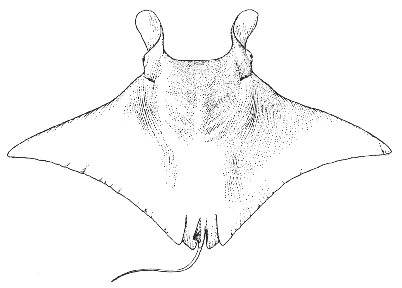Devil ray Manta birostris (Donndorff) 1798
[Bigelow and Schroeder, 1953, p. 502.]

Figure 33.—Devil ray (Manta birostris), juvenile male, 11 feet 5½ inches wide, Bimini, Bahamas. From Bigelow and Schroeder. Drawing by E. N. Fischer.
Description—
The so-called cephalic fins of the devil ray, pointing forward, give it so distinctive an appearance that it could not be confused with any other fish, except for some other member of its own family. And it is marked off from all others of these that are known in the Atlantic by the [page 78] position of its mouth, which extends across the front of its head instead of being on the under side. Its cephalic fins are about one-half as broad at the base as they are long, with thin lower edges and thick fleshy upper edges and rounded tips, and each arises nearly vertical from the side of the head. When the owner is swimming they point directly forward, but when the ray is feeding, they can be curved inward, one toward the other until their tips nearly meet in front of the mouth. The disc (not counting the cephalic fins) is a little more than twice as broad as long, with tapering outer corners. The tail measured from the cloaca is at least as long as the body from cloaca to front of head and perhaps longer still if not damaged. And it bears a small rounded dorsal fin on its base. Some specimens have been described as having one or two small tail spines close behind the dorsal fins. However, those that we have seen have had none, but a rounded knob in its place, supported by a mass of bony tissue with a minute pointed spur on the upper side that can be felt but does not break the skin. The skin of disc, pelvic fin, and tail is roughened with small tubercles, below as well as above. The mouth is very wide, extending across a little more than one-half the whole breadth of the front of the head. And the teeth, the lower jaw only, are minute and very numerous; we counted about 270 series in about 12 to 18 rows or a total of about 4,500 in one specimen about 11½ feet wide. The gill openings are noticeably long.
Color—
The upper side varies from reddish or olive brown to bluish slate colored or black, either plain or with various white markings. The lower side is white toward the center of the disc but gray around the margins, and there may be various dark blotches in the region of the gills and on the abdomen. The rear part of the tail is gray.
Size—
This giant ray matures when about 14 to 15 feet wide. They commonly grow to 18 feet or so, and there are recent records of measured specimens 19 feet 8 inches, 21 feet 2 inches, and 22 feet wide. One 14 feet wide weighed 1,686 pounds, one from the Galapagos Islands, 18 feet wide, 2,310 pounds; and one of 20 feet taken long ago off Venezuela weighed 3,502 pounds.
General range—
Manta is known in the Atlantic from middle Brazil to the Carolinas and as a rare [page 79] stray to southern New England and Georges Bank; from Bermuda; from Madeira; and from tropical West Africa. Mantas are also widespread in the tropical-subtropical belt of the Pacific and Indian Oceans, but it is not yet known whether they are identical with the Atlantic species or not.
Occurrence in the Gulf of Maine—
The only reason for mentioning this giant ray here is that a pair, judged to be 18 to 19 feet wide, were encountered on the southeast part of Georges Bank late in August 1949, by Capt. Henry W. Klimm, while out after swordfish, and so close at hand that their cephalic fins and purplish color were noted. The nearest record to the westward and southward is of one 19 feet wide, weighing 1,686 pounds, harpooned by a sword fisherman a few miles off Block Island and landed there in August 1921.[84]
[84] Reported by Gudger (Science, N. Ser., vol. 55, 1922, p. 339). There are photographs of this specimen in the American Museum of Natural History in New York.